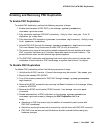
Communication Manager Maintenance-Object Repair Procedures
592 Maintenance Procedures for Avaya Communication Manager 3.0, Media Gateways and Servers
Resolving Poor State of Health
When both PNCs do not have an all-zero SOH (perfect health), use the following steps to
identify and repair the problem.
1. Look for PNC component alarms (major or minor) for the PNC side without an all-zero SOH.
The standby PNC should be repaired first.
2. Busy-out the standby PNC.
3. Follow the appropriate diagnostic and repair procedures for the alarmed PNC components
just as with a simplex PNC. Both the alarm and error logs should be examined to isolate the
fault.
4. Verify that the related PNC’s SOH is restored to all zeros.
5. Release the standby PNC.
Refresh and Unrefresh of the Standby PNC
In a fully-functional PNC with healthy standby and active sides, the standby PNC has a
complete set of call connections corresponding to those in the active PNC. If, however, the
standby PNC’s state of health degrades, a selective unrefresh of those connections that utilize
the faulted component(s) is performed. If the standby PNC’s health improves, a selective
refresh of connections on the affected route is performed so that call setup is consistent
between the active PNC and the healthy parts of the standby PNC.
The Standby Refreshed? field on the status pnc screen does not refer to the selective type
of refresh. It refers only to a global refresh that is performed when:
● The system is initialized and PNC duplication is enabled.
● There has been a spontaneous PNC interchange.
● The standby PNC has been released from busy-out.
● A system reset of level 2 or higher has taken place.
The Refreshed field may display yes when in fact the standby is partially unrefreshed. An
interchange into an incompletely refreshed standby results in dropped calls. This can happen
when a more severe fault occurs on the active PNC or when reset pnc interchange is
used with the override option.


















